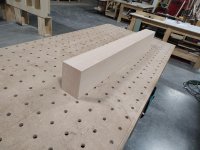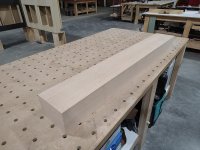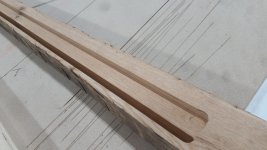squall_line said:
I'm sure there's literature on this somewhere, and the likely answer is "it depends", but is there a general guideline for which direction the end panels get their grain/waterfall when making a box mantle? My brain starts to break down thinking through all of the different ways to waterfall/grain match a piece like this...
You're right.....it depends. I do "waterfall" ends on all kinds of things, but on something like this, where it is mounted (more or less) at eye level, the focus is on the wrap around.
The real debate is which gets the better face, top or bottom? (assuming that one face does look better than the other) It just so happens that on this one, you would never know which was which.
Funny enough, I made this out of a piece of drop, that was in the rack, back by the CNC area. There wasn't enough of it though. All I could get from it was enough for the front face/ends and one that could be either top or bottom. I had to go diving in the veneer scrap shelf, and got super lucky. Not only was there a piece that was just as rift-sawn looking, but it was very close in color too. So much so, that when I challenged the other guy, who was working that day, that he guessed wrong.
I have done several of the rustic beam style mantles too. I did one for a lawyer's office, where he supplied the timber. He had several pieces that were structural members of the old "Ohio Penitentiary"
that used to be just west of downtown Columbus. It was closed decades ago and most of the buildings demolished. A few of them lasted longer. Somehow, he got ahold of a few of them, during one of the later dismantlings, and stashed them for years. He brought them to me, to make a waterfall-leg type console table for the lobby, of his office, and a couple of benches, of his design.
When I was done, there was one left over. It was about 9 feet long, 6" x 8" of some really old-growth pine. He said I could have it, so I stored it in the corner, of my area, waiting for something special. That special thing was the fire. I lost it, along with the Maple crotch piece that came from my niece's yard. That tree was special to her. When it blew down, in a storm, she gave me my choice of pieces.
I had to sliced up and stickered, for several years. I had just checked it for moisture the week before. It was ready to use. Made good fuel, that's about it. [scared]
I have done a few from barn siding too. They were more like this, just more rustic.
Oh, yeah. I did the one's in the production manager's office that way.
The solid slabs, with natural end grain are the hardest to mount, especially if you want the "no hardware" look. It takes a bunch of hollowing. Apparently, that was 3 years ago? wow time flies





